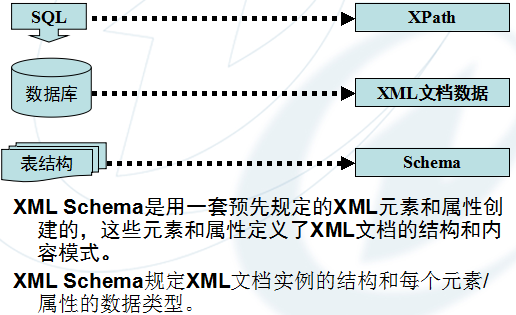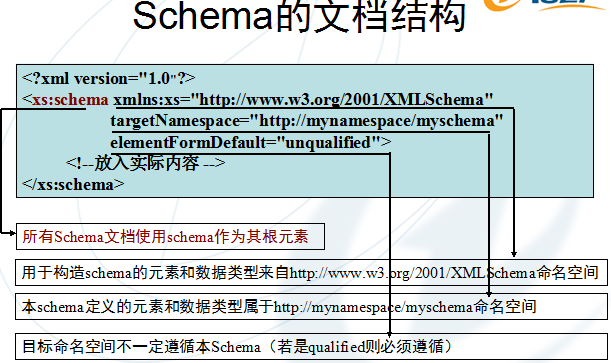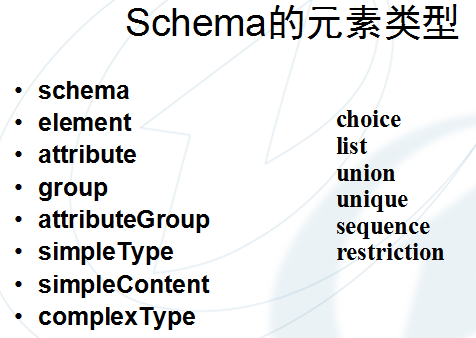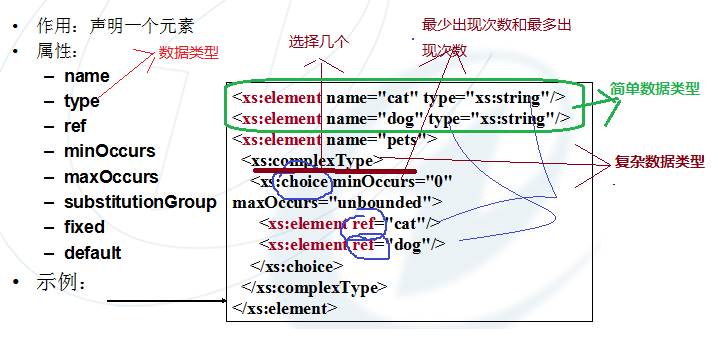xml之Schema架构
1、什么是Schema架构

2、Schema文档结构

3、Schema元素类型

1》element元素

<!--简单数据;类型-->
<xs:element name="dog" type="xs:string"></xs:element>
<xs:element name="cat" type="xs:string"></xs:element> <!--复杂数据类型-->
<xs:element name="pets">
<xs:complexType>
<xs:choice minOccurs="0" maxOccurs="unbounded">
<xs:element ref="dog" ></xs:element>
<xs:element ref="cat"></xs:element>
</xs:choice>
</xs:complexType>
</xs:element>
element元素
2》group元素
属性:name、ref
<!--group元素-->
<xs:element name="ele1" type="xs:string"></xs:element>
<xs:element name="ele2" type="xs:string"></xs:element>
<xs:attribute name="myAttrituate1" type="xs:decimal"></xs:attribute>
<!--group含有 name 和 ref 两个属性-->
<!--位于 根节点schema下面的 group 没有 ref 元素-->
<xs:group name="myGroup1">
<xs:sequence>
<xs:element ref="ele1"></xs:element>
<xs:element name="ele3" type="xs:string"></xs:element>
</xs:sequence>
</xs:group> <xs:complexType name="comp1">
<xs:group ref="myGroup1"></xs:group>
<xs:attribute ref="attr2"></xs:attribute>
</xs:complexType>
group元素
3》attribute元素(为元素声明属性)
属性:name、type、ref
<xs:attribute name="myAttrituate1" type="xs:decimal"></xs:attribute> <!--attribute元素:含有属性:name/ref/type-->
<xs:attribute name="attr2" type="xs:string"></xs:attribute>
attribute元素
4》attributeGroup元素
作用:将一组属性声明在一起,一边被复杂类型重复使用
属性:name、ref
<!--attributeGroup元素,含有属性 name / ref-->
<xs:attributeGroup name="myattributeGroup">
<xs:attribute name="attribute1" type="xs:string"></xs:attribute>
<xs:attribute name="attribute2" type="xs:string"></xs:attribute>
</xs:attributeGroup> <!--下面这个 attributeGroup 就是 指向 上面的 那个 attributeGroup-->
<xs:attributeGroup name="myattributeRefGroup">
<xs:attributeGroup ref="myattributeGroup"></xs:attributeGroup>
</xs:attributeGroup>
attributeGroup
5》simpleType元素
作用:定义一个简单类型,它决定了元素和属性值的约束和相关信息
属性:name
内容:应用已经存在的简单类型,三种方式
restrict→限定一个范围
list→从列表中选择
union→包含一个值的集合
<!--simpleType元素(决定 元素和属性值的 约束和相关信息)含有属性 name,,含有三种形式的 内容-->
<!--第一种内容 : restriction(限制,简单类型是 在什么)-->
<xs:simpleType name="restrictionSimpleType">
<!--限制 内容在 一定范围内;;注意 base 是不能 缺失的(内容 继承自 什么)-->
<xs:restriction base="xs:integer">
<xs:minInclusive value="0"></xs:minInclusive>
<xs:maxInclusive value="100"></xs:maxInclusive>
</xs:restriction>
</xs:simpleType> <!--第二种 内容的 形式 list(列表,,只允许用户 在指定的 列表中间 选择一个值)-->
<xs:simpleType name="listSimpleType">
<xs:list itemType="xs:date"></xs:list> <!--约束 简单类型的 内容只允许 是 日期中的 一个日期-->
</xs:simpleType> <!--第三种 内容的 形式 union(合并,,就是 一个 简单类型 包含 一个 简单类型的集合) --> <!--下面的 这个 例子 非常经典,,一定要记住-->
<xs:simpleType name="roadBikeSize">
<xs:restriction base="xs:positiveInteger"><!--公路自行车的 尺寸-->
<xs:enumeration value="20"></xs:enumeration>
<xs:enumeration value="40"></xs:enumeration>
<xs:enumeration value="60"></xs:enumeration>
</xs:restriction>
</xs:simpleType> <xs:simpleType name="mountainbikesize"><!--山地车的 尺寸-->
<xs:restriction base="xs:string">
<xs:enumeration value="small"></xs:enumeration>
<xs:enumeration value="middle"></xs:enumeration>
<xs:enumeration value="big"></xs:enumeration>
</xs:restriction>
</xs:simpleType> <xs:attribute name="sizeOfBike">
<xs:simpleType>
<xs:union>
<xs:simpleType>
<xs:restriction base="roadBikeSize"></xs:restriction>
</xs:simpleType>
<xs:simpleType>
<xs:restriction base="mountainbikesize"></xs:restriction>
</xs:simpleType>
</xs:union>
</xs:simpleType>
</xs:attribute> <xs:element name="bike">
<xs:complexType><!--因为 元素 含有属性 ,所以要使用 复杂类型-->
<xs:attribute ref="sizeOfBike"></xs:attribute>
</xs:complexType>
</xs:element>
simpleType三种方式
6》complexType元素
作用:定义一个复合类型,它决定了一组元素和属性值的约束和相关信息
属性:name
<xs:complexType name="sizeOfShoes">
<xs:simpleContent>
<xs:extension base="xs:decimal">
<xs:attribute name="sizing" type="xs:string"></xs:attribute>
</xs:extension>
</xs:simpleContent>
</xs:complexType> <xs:element name="shoes" type="sizeOfShoes"></xs:element>
complexType元素
(*)complexType与simpleType区别:
1、simpleType类型的元素中不能包含元素或者属性。
2、当需要声明一个元素的子元素和/或属性时,用complexType;
3、当需要基于内置的基本数据类型定义一个新的数据类型时,用simpleType。
7》simpleContent元素
作用:应用于complexType,对它的内容进行限制和扩展
<xs:element name="shoes2">
<xs:complexType>
<xs:simpleContent >
<xs:extension base="xs:decimal"><!--这里的 base 继承 是限制 simpleContent 的-->
<xs:attribute name="sizing">
<xs:simpleType>
<xs:restriction base="xs:string"><!--这里的 base是 限制 simpleType(也就是限制 attribute)-->
<xs:enumeration value="big"></xs:enumeration>
<xs:enumeration value="middle"></xs:enumeration>
<xs:enumeration value="small"></xs:enumeration>
</xs:restriction>
</xs:simpleType>
</xs:attribute>
</xs:extension>
</xs:simpleContent>
</xs:complexType>
</xs:element>
simpleContent元素
8》choice元素
作用:允许唯一的一个元素从一个组中被选择
属性:maxOccurs、minOccurs
<xs:element name="pets2">
<xs:complexType>
<xs:choice minOccurs="1" maxOccurs="2"> <!--设置 能够选择的 项数(最少选择一项,最多选择2项)-->
<xs:element name="dog">
<xs:simpleType>
<xs:restriction base="xs:string">
<xs:enumeration value="哈巴"></xs:enumeration>
<xs:enumeration value="藏獒"></xs:enumeration>
</xs:restriction>
</xs:simpleType>
</xs:element>
<xs:element name="cat">
<xs:simpleType>
<xs:restriction base="xs:string">
<xs:enumeration value="波斯猫"></xs:enumeration>
<xs:enumeration value="tom"></xs:enumeration>
</xs:restriction>
</xs:simpleType>
</xs:element>
</xs:choice>
</xs:complexType>
</xs:element>
choice元素
9》unique元素
作用:定义一个元素或属性值,它必须在特定的范围内
<xs:complexType name="CustomerOrderType">
<xs:sequence>
<xs:element name="item" minOccurs="0" maxOccurs="unbounded">
<xs:complexType>
<xs:attribute name="itemID" type="xs:string"></xs:attribute>
</xs:complexType>
</xs:element>
</xs:sequence>
<xs:attribute name="CustomerId" type="xs:string"></xs:attribute>
</xs:complexType> <xs:element name="ordersByCustomer">
<xs:complexType><!--下面含有子元素-->
<xs:sequence>
<xs:element name="customerOrderType" type="CustomerOrderType" minOccurs="0" maxOccurs="unbounded"></xs:element>
</xs:sequence>
</xs:complexType>
<xs:unique name="oneCustomerOrdersforEachCustomerID">
<xs:selector xpath="mstns:customerOrderType"></xs:selector>
<xs:field xpath="@CustomerId"></xs:field>
</xs:unique>
</xs:element>
unique元素
10》sequence元素
作用:按照顺序出现某些元素
<xs:complexType name="pets">
<xs:sequence>
<xs:element name="dog"></xs:element>
<xs:element name="cat"></xs:element>
</xs:sequence>
</xs:complexType>
sequence元素
4、完整示例代码
<xs:element name="purchaseOrder" type="PurchaseOrderType"></xs:element>
<xs:element name="comment" type="xs:string"></xs:element>
<xs:complexType name="PurchaseOrderType">
<!--下面是子元素:依次出现下面子元素-->
<xs:sequence>
<xs:element name="shipTo" type="USAAddress"></xs:element>
<xs:element name="billTo" type="USAAddress"></xs:element>
<xs:element name="items" type="Items"></xs:element>
</xs:sequence>
<xs:attribute name="orderDate" type="xs:date"></xs:attribute>
</xs:complexType> <xs:complexType name="USAAddress">
<xs:sequence>
<xs:element name="name"></xs:element>
<xs:element name="street"></xs:element>
<xs:element name="city"></xs:element>
<xs:element name="state"></xs:element>
</xs:sequence>
<xs:attribute name="country" type="xs:string" fixed="US"></xs:attribute><!--fixed="US"表示 如果没有 声明此属性,那么默认 就是 US-->
</xs:complexType> <xs:complexType name="Items">
<xs:sequence>
<xs:element name="productName" type="xs:string"></xs:element>
<xs:element name="quantity">
<xs:simpleType>
<xs:restriction base="xs:positiveInteger">
<xs:maxExclusive value="100"></xs:maxExclusive>
</xs:restriction>
</xs:simpleType>
</xs:element>
</xs:sequence>
</xs:complexType>
</xs:schema>
示例代码
xml之Schema架构的更多相关文章
- XML和Schema命名空间详解
来源:https://blog.csdn.net/wanghuan203/article/details/9204337 XML和Schema具有无关平台,技术厂商,简单,规范统一等特点,极具开放性, ...
- xml和xsd架构文档相关知识
1.使用架构(XSD)验证XML文件 2.使用自动生成工具: 工具目录:C:\Program Files (x86)\Microsoft SDKs\Windows\v8.0A\bin\NETFX 4. ...
- xml语法、DTD约束xml、Schema约束xml、DOM解析xml
今日大纲 1.什么是xml.xml的作用 2.xml的语法 3.DTD约束xml 4.Schema约束xml 5.DOM解析xml 1.什么是xml.xml的作用 1.1.xml介绍 在前面学习的ht ...
- JavaScripts学习日记——XML DTD Schema
今日关键词: XML DTD Schema 1.XML 1 XML的概述 1.1 什么是XML XML全称为Extensible Markup Language,意思是可扩展的标记语言.XML语法上和 ...
- XML的Schema约束
XSD文档至少要包含:schema根元素和XML模式命名空间的定义.元素定义.需要注意的是XSD中必须定义一个且只能定义一个schema根元素,根元素中包括模式的约束,XML模式命名空间的定义,其他命 ...
- XML和Schema
2017-11-03 19:33:56 XML:Extensible Markup Language,也就是可扩展标记语言.XML工具使处理和转化信息变得十分容易和方便. XML和HTML格式是古老的 ...
- 怎样用Google APIs和Google的应用系统进行集成(5)----怎样把Google Tasks的JSON Schema转换成XML的Schema(XSD)?
前面说了一些Google API的介绍,可是在实际的开发其中,我们可能须要把Google RESTful API返回的JSON数据转换成XML数据输入到第三方系统,这在企业应用集成里面很的常见. 那么 ...
- 怎样用Google APIs和Google的应用系统进行集成(8)----怎样把Google Blogger(博客)的JSON Schema转换成XML的Schema(XSD)?
在Google RESTFul API中,Google Blogger API(Google博客API)应该和我们的生活离得近期:由于差点儿非常多人每天都在看博客,都在写博客,都听说过博客.在前面的G ...
- solrconfig.xml和schema.xml说明
1. solrconfig.xml solrconfig.xml配置文件主要定义了SOLR的一些处理规则,包括索引数据的存放位置,更新,删除,查询的一些规则配置. 1.1. datadir节点 ...
随机推荐
- poj3122 pie
方法:二分. 题目意思:要过生日了,我请大家吃pie,然后人数一共是f+1(我自己).每个人的pie不能是拼接的,而且每个人的面积是一样的,这样就用二分枚举. 范围是0-最大的那块pie. 然后用每一 ...
- SQLserver2012 修改数据库架构
还原数据库以后,发现有一张表的架构不对,执行sql提示:对象名无效.
- 【转】Linux模式设计5-位图操作
通过位图提供的两种状态可以在非常节约内存的情况下表示开关变量,并且同类这类变量可以紧凑而高效的统一进行处理.有很多内核子系统都需要位图的支持,但是不同的情况又需要不同的位图个数,比如SMP系统上的CP ...
- 解决Access连接 accdb 不可识别的数据库格式异常
在Access07之前的数据库后缀名均为*.mdb 而连接字符串写成Provider=Microsoft.Jet.OLEDB.4.0;Data Source=C:\myFolder\*.mdb ;Pe ...
- C#语法基础和面向对象编程
1.C#语法基础 http://www.cnblogs.com/tonney/archive/2011/03/16/1986456.html 2.C#与面向对象基础 很棒的资源,简明扼要,介绍的非常清 ...
- Nginx Location匹配举例
1.location / { if (!-f $request_filename){ rewrite ^/(.+)$ /uri.php last; }} ...
- ubuntu 12.04 LTS(64位)安装apache2
在网上找了很多文章,说法不一,不知道应该用哪种方法,后来想就用其中最简单的吧,装不好再卸了重装, 然后就...装上了,用的是tar包源码安装,下面是步骤 1.去官网下载apache2.2.25源码包, ...
- C++求最大公约数
题目内容:求两个正整数的最大公约数. 输入描述:输入数据含有不多于50对的数据,每对数据由两个正整数(0<n1,n2<232)组成. 输出描述:对于每组数据n1和n2,计算最大公约数,每个 ...
- CentOS 7.0默认使用的是firewall作为防火墙,这里改为iptables防火墙。
firewall:systemctl start firewalld.service#启动firewallsystemctl stop firewalld.service#停止firewallsyst ...
- a 标签 跳转4种类型
<a href='' target=''>中的target有4种参数: '_self' , '_parent' , '_top' 和 '_blank' 在没有使用框架 ...
